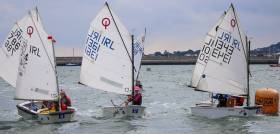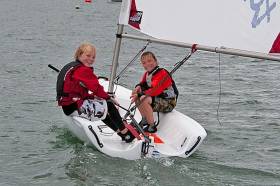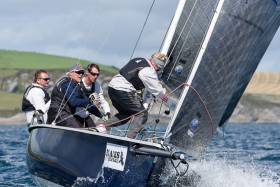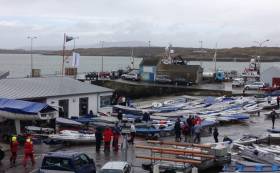Displaying items by tag: Baltimore Sailing Club
140 Sign–Up For Optimist Baltimore Spring Training Week 2017
The traditional Optimist Baltimore Spring Training Week event, one of the top International sailing clinics in Europe, takes place next week.
Baltimore Week is Ireland’s largest sailing camp and this year has seen over 140 Optimist sailors from 8 – 15 yrs old sign up for the event.
It is an action packed week of fun for all the family. This event is about making friends and having fun on and off the water in a safe environment.
A team of International coaches from Greece, & Poland are joined by top Irish coaches to provide training for sailors of all competencies, from those who have only recently started to sail to those who are competing internationally.
The week is very much a family-oriented event, with a programme of activities for children too young to sail, and events also organised for adults, such as the ‘How to Rig an Oppi’ class for novice parents! Schull & Fitbones provides activities for those 5 years and upwards who are not yet sailing. They do Baltimore Treasure Hunt and Playground games, Sherkin Island trip and an Adventure Challenge in Lough Hyne Woods.
Evening activities are also on offer, including the ever-popular cinema night and also a disco night. In addition the week finishes off with a one day regatta which helps sailors consolidate all they have learnt during the week & to put it into practice.
The annual event is hosted by Baltimore Sailing Club, which is set in the beautiful harbour of Baltimore, West Cork.
IODAI Forum 2017
An IODAI forum takes place during the Baltimore week where all parents are invited to express their views or seek information on the running of the Optimist class.
Places Available For 2017 ISA Sailing Courses At Baltimore SC
#TrySailing - Baltimore Sailing Club is now taking bookings for places on its 2017 ISA summer sailing courses.
The first course runs over three weeks from Monday 3 to Friday 21 July, while a second three-week course runs the following month from Tuesday 8 to Friday 25 August.
In addition, a Junior Try Sailing Taster Course runs from Monday 24 to Friday 28 July comprising two half-day courses each day.
Application forms are available on the Baltimore SC website HERE.
1720 Championship Victory for Peter O'Leary's 'Dutch Gold' in Kinsale
After missing out on Day 2 of the 1720 Irish championship entirely due to inclement weather, OOD Peter Crowley and his team were on the water at Kinsale before 09:00 this morning and managed to complete a full programme of races for the 1720 National Championships writes Peadar Murphy. The wind today was light and shifting, but four highly competitive races were still squeezed in and had everyone ashore just before the rain swept in again.
After the first four races on Friday, Anthony O’Leary on “Antix” led from the Byrne and Wilson outfit on “ZING” and Aoife English on “Atara”. However today, the next generation of O’Learys shot to the fore on “Dutch Gold” (newly arrived from Holland!) with Peter on the helm and Robert midship providing the fleet with a masterclass in 1720 sailing in light airs. Three bullets and a second place finish rightly crowning them as the 1720 National Champions for 2016 and bringing the title to Baltimore Sailing Club, capping off a memorable week for that part of the world!
Though never quite at the front of the fleet today, Padraig Byrne and Don Wilson on “ZING” had done enough on Friday to ensure that their lesser results today still merited a second place overall. The lighter airs today seemed to suit a number of boats that hadn’t been quite in the running in strong stuff on Friday; Fionn Lyden on Baltimore Sailing Club boat “Live Wire” had a strong showing today, and might have been pushed a bit by fellow Baltimore boat “Smile n’ Wave”, though their challenge ran out of steam later in the day. Also prominent today were Paul Gibbons’ “Wahoo” and Dun Laoghaire visitor Kenneth Rumball on “Team INSS”. However, despite an off day today - Anthony O”Leary’s “Antix” came home in third overall with five points to spare over “Wahoo”.
However, the undoubted winner of the Blacks of Kinsale 1720 National Championships was Peter O’Leary.
Laser Munsters Blown Out at Baltimore Sailing Club
Despite mustering a fleet of 120 dinghies for the first regional championships of the year there was no Laser racing at all last weekend at Baltimore Sailing Club due to gale force winds. Winds were never less than 20–25 knots with gusts up to 50 for the entire weekend until that is, late on Sunday afternoon when it was warm, sunny and a perfect 10–knots as the fleet were packing boats and heading for home.
The Munster championships, which was a ranking ladder cut off event for Dun Laoghaire's Laser Radial Youth World Championships in July, is to be rescheduled.
The next event on the Laser calendar is the Ulster Championships at County Antrim Yacht Club at Whitehead on April 23rd
Optimists Prepare for Baltimore Training Week 2016
The Irish Optimist Dinghy Association of Ireland (IODAI) will hold its spring training week at Baltimore sailing Club in West Cork over the February 2016 Mid-term break. This is Ireland’s largest sailing camp and generally caters for up to 160 sailors from 8 – 15 yrs old.
The village of Baltimore will be effectively taken over by approximately 160 keen sailors and their families for the week. A team of International coaches from Greece, & Poland are joined by top Irish coaches to provide training for sailors of all competencies, from those who have only recently started to sail to those who are competing internationally.
The Baltimore event is considered to be one of the top International clinics in Europe. It is very much a family-oriented event, with a programme of activities for children too young to sail, and events also organised for adults, such as the ‘How to Rig an Oppi’ class for novice parents! Schull & Fitbones
provides activities for those 5 years and upwards who are not yet sailing, they do Baltimore Treasure Hunt and Playground games, Sherkin Island trip and an Adventure Challenge in Lough Hyne Woods .
The event is organised by IODAI which is comprised of volunteers, which are the parents of sailors. It takes 25 – 30 volunteers per day to run the event efficiently and the overall event is managed by Mandy Kelly and assisted by Sara Lacy both parents of sailors.
Evening activities are also on offer, including the ever-popular ‘a cinema night, disco night and of course the cake competition on the last day of sailing. In addition the week finishes off with a one day regatta which helps sailors consolidate all they have learnt during the week & to put it into practice.
An IODAI forum takes place during the Baltimore week where all parents are invited to express their views or seek information on the running of the Optimist class.
Baltimore Sailing Club Laser Icicle Regatta for December
Baltimore Sailing Club in West Cork will stage its annual Laser Icicle Regatta on Saturday and Sunday 5th & 6th December.
The series will be over six races, with three races on Saturday and three on Sunday. Lasers using the Standard, Radial or 4.7 Rig are entitled to compete.
For more information please see the available attachment documents below (Notice of Race and Sailing Instructions) for download:
#1720 – There was a clear cut victory in the 2015 1720 sportsboat National Championships for Tom Durcan's T–Bone steered by Alex Barry of Monkstown Bay SC yesterday. The 14-boat fleet sailed out in dense fog and had to wait for two hours for sufficient breeze to get the final two races of the event away.
In the end, T-Bone, with double Olympian Peter O'Leary on board, continued its overall lead and did not have to sail the last race of the day to secure the title. It is the second top performance by Alex Barry this season, the Cork dinghy helm took Bronze at the RS400 Eurocup in France this month too.
A tie on overall points was decided in Antix and Anthony O'Leary's favour for second with Ben Cooke's Smile and Wave third. Fourth was Dun Laoghaire's Team INSS sailed by Kenneth and Alex Rumball who were flying the flag for Leinster at what was a Munster dominated event.
Official results sheet below.
Durcan's 'T-Bone' Leads at the 1720 Nationals
#1720 – A 1,1,4 scored in yesterday's first three races of the 1720 Nationals at Baltimore Sailing Club puts Royal Cork's Tom Durcan sailing T–Bone at the top of the 14–boat fleet.
In a dramatic start to the 2015 title decider, one boat lost its rig in the final race yesterday afternoon.
Second is Ben Cooke's Smile 'n' Wave on seven with Kenny Rumball's Team INSS from Dun Laoghaire third on nine points. Provisional results are downloadable below.
Union Chandlery to Sponsor 1720 Euros at Royal Cork
#1720 – No sooner had Baltimore Sailing Club announced its 1720 National Championships last week than Royal Cork Yacht Club unveils its Union Chandlery sponsored 1720 European Championships to be held in the first week of September.
The nine race regatta will run from September 3rd to 5th and the proposed schedule of races is: Thursday 3rd of September up to four races; four more on Friday, concluding with one final race on Saturday.
More details in the NOR downloadable below.
#1720 – The popular West Cork sailing Village of Baltimore will next month play host to the 1720 National Championships which will be sailed in the picturesque setting of Roaring water Bay. The event is sponsored by Danske Bank. The Cork harbour 1720 Sportsboat fleet is still going strong in Ireland and with boats travelling down from Dublin, Crosshaven and even the UK to join the large local fleet already based in Baltimore.
The 2015 1720 National Championships will be organised by the Baltimore Sailing Club (BSC) in conjunction with the 1720 Sportsboat Class Association from Thursday 18th to Saturday 20th June 2015.
This year's event looks to be attracting around some 20 entries, a weekend ahead of the ICRA Nationals and Sovereign's Cup Kinsale. As well as the great racing agenda, the 1720 class say there are good après-sail activities planned for the evenings including a big BBQ on the last night at the recently extended and renovated clubhouse of BSC. NOR and entry forms available for download below.
































































